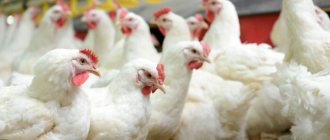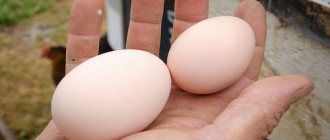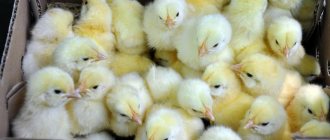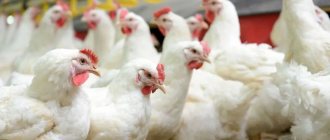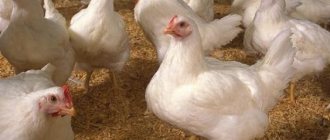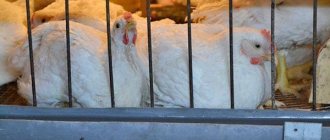Broilers are a type of chicken bred for the meat market. Poultry does not require complex care and a long feeding time compared to piglets and calves, so the payback period is much shorter. For the business to be profitable, a clear and well-thought-out business plan for broiler breeding with calculations at the start and preliminary income is required.
About business
As a business, broiler breeding is one of the most profitable branches of livestock farming, since the period of raising chickens lasts about 70 days, while cattle must be raised for at least 1-2 years. Large farms specializing in poultry usually develop in the following directions:
- Incubation and rearing of chicks
- Breeding new breeds of birds
- Creation of compound feeds
- Sale of meat and by-products
Moreover, benefits can be obtained even with very small deposits. The easiest way to do this is to raise day-old chicks from eggs. This will already bring benefits, because a day-old chick costs three times more than an egg (25 rubles and 8 rubles, respectively). When you have accumulated a certain starting capital in this way, you can arrange everything for raising broilers.
Required documents
To open such a business, you can use either an individual entrepreneur or an LLC. If you do not plan to expand, then it is enough to open an individual entrepreneur. It will cost less and take less time. It is more profitable to choose a simplified form of taxation.
You will also need to obtain permission from the following regulatory authorities:
- Rospotrebnadzor.
- SES.
- An organization that deals with veterinary quality control.
Advantages and disadvantages
Although broiler breeding as a business is a fairly promising niche, this type of business has both advantages and disadvantages. The most important advantages are the rapid growth of chickens, as well as the ability to use a small room. For 1 sq.m. area can accommodate as many as 20 birds.
Of course, there are certain risks:
- Infection of birds with various infections
- Insufficient weight gain due to the use of low-quality feed
- Falling demand for chicken meat
To avoid troubles, you should purchase eggs only from trusted suppliers, having discussed all the nuances in advance and drawn up contracts. Chickens should be purchased only from well-established hatcheries.
Main risks
The main danger is exposure of chickens to diseases (bird flu, helminthiasis, pasteurellosis, pullorosis, coccidiosis). Insurance will help reduce risks; you can use one of the programs developed for farms. Purchasing chickens in specialized nurseries, using vitamins and vaccination will slightly increase the cost of chicken meat and eggs, but will allow you to avoid significant losses due to mass mortality of poultry on your farm.
The unpredictable behavior of grain prices seriously complicates the work. They make up the main part of the poultry diet. It is not difficult to minimize losses if you have your own plot and grow your own cereal crops.
Broiler farming
Depending on the purpose for which you raise chickens (for slaughter for meat or for direct sale), raising broiler chickens as a business will have its differences.
Raised for meat
In this case, you should purchase chickens at one month of age. They are placed in a chicken coop where the temperature is maintained at 30⁰C, and the lighting system operates according to the following scheme: two hours on and two hours off.
As for feeding, it is better to give preference to feed with the following composition: half corn, the rest is milk powder, wheat, meal, fish and grass meal, minerals, yeast, feed fat.
In order for birds to gain weight faster, their mobility should be limited. If all the conditions are met correctly, then within 70 days you will receive a healthy bird that has gained weight.
Raising chicks for direct sale
Chickens for direct sale are raised either naturally (under a brood hen) or using an incubator. The first option, although more natural, is also more complex. The main difficulty is determining the right moment. Place 10-20 eggs under the brood hen, fence and feed the bird regularly. This method has one serious drawback: the hen can simply throw the eggs, and all efforts will go down the drain.
Growing in an incubator is simpler and more promising. About a hundred eggs can be placed in a small apparatus, and about 9-10 thousand in large industrial ones. Although most devices have an automatic turning function, you should not rely too much on technology in this matter. You should also take care in advance to find a backup source of electricity or a water heating system in case the central electricity is turned off for some reason.
Profitability
A 3-month-old broiler chicken reaches a weight of 3 kg. The market value of domestic chicken meat is unstable. A lot depends on who your buyer is. If you sell carcasses in bulk, you should expect a price of 150 rubles per 1 kg. At retail prices rise to 250 rubles per 1 kg. The cost of keeping each chicken should not exceed 200 rubles. This way you can achieve normal profits.
The situation with the sale of eggs is as follows. If you have 50 laying hens in your house, you should count on 40 eggs per day. The average price of a dozen domestic eggs is about 130 rubles. You can earn about 150,000 rubles per month from selling them.
Under normal circumstances and proper organization of the farm, payback is achieved in 9-12 months. Breeding broilers for meat shows profitability in the range of 50-60%, laying hens - 45%.
Business registration
Beginning livestock breeders often register their business as individual entrepreneurs. This is a very good solution for those cases where there are no plans to create a large enterprise offering its products on an industrial scale to large supermarket chains, large butcher shops and large enterprises in general.
For individual entrepreneurs, a simpler taxation system is provided, which is a definite advantage. A more complex option is an LLC - this method provides more opportunities, but also requires large financial and time investments.
The next step will be to obtain all the necessary certificates and permits: from the SES, Rospotrebnadzor, fire inspectorate, veterinary quality control organization, social funds, etc.
Advertising is never superfluous
The success of sales largely depends on how informed potential buyers are about poultry farm products. In the business plan, and then in the enterprise budget, advertising costs should be a separate line. The services of advertising agencies are not cheap, but they often carry out promotions to attract advertisers. There are other ways to promote a product to consumers without the ruinous costs of agencies. The poultry farmer will have to master the basics of the advertising business so that the consumer learns about the excellent quality of the poultry farm’s products. It is possible to use all suitable channels for disseminating information:
- newspapers and free classifieds websites;
- paid advertising printing;
- installation of banners and distribution of leaflets;
- website on the Internet and registration on social networks;
- poultry breeding clubs and forums, public business events;
- help from relatives, friends and acquaintances (word of mouth).
It is necessary to monitor the actions and advertising campaigns of competitors and respond in a timely manner to negative reviews and anti-advertising.
Site and premises
The conditions for keeping broilers on farms are regulated by order of the Ministry of Agriculture of the Russian Federation (04/03/2006). It specifies the following requirements for a business plan for broiler breeding:
- The room should be made of materials that are easy to clean.
- There should be a straw mat on the floor. As an option - from sawdust or shavings.
- The farm must have good ventilation.
- Walking areas must be fenced.
- There must be water drains on the site.
- Feeders should be accessible to birds, 4-5 cm in length for young birds and 6-8 cm for large birds.
- The length of the drinkers should be at least 1-3 cm per bird.
To save effort and time, as well as from the point of view of maintaining optimal conditions, lighting and heating systems should be automatic. The optimal coating for walls is a lime solution. This will protect the broilers from infections.
Broilers must be kept either in cages or directly on the floor. If you prefer the first option, then you should calculate 12-16 birds per 1 sq.m. The thickness of the bedding made from sawdust or shavings must be at least 10 cm. For each new batch of boilers, a new bedding is taken.
It is better to automate the feeding and water supply process. For chicks, it is better to purchase tray-type feeders and vacuum drinkers. For adult birds, automatic equipment is suitable.
If you decide to keep broilers in cages, you can either order them or make them yourself. The dimensions must be as follows: 1 m high, 0.4 m wide, there must be a tray located at an angle (0.2 m in front and 0.1 m in the back). For 1 sq.m. The cages can accommodate 20-25 birds.
It is imperative to monitor the gas concentration (norm - up to 15 mg/cub.m for ammonia, 5 mg/cub.m for hydrogen sulfide), noise level (norm - up to 90 dB) and air speed (norm 0.3-0.4 m/s) indoors!
Timeframe for putting the poultry house into operation
Based on the fact that the future entrepreneur’s farm does not have premises for keeping broilers, it is necessary to plan the construction of a poultry house, taking into account the climatic conditions in the region. Construction work can be carried out at any time of the year, but it is better to pour the foundation into regular soil rather than frozen soil. Broiler meat is purchased regardless of the calendar. But young animals adapt faster in warm weather. In spring and summer, costs for lighting and heating the poultry house are reduced. Therefore, we plan to start work in the spring. We note the stages of work and the timing of their completion in the table:
| Type of work / Time frame | Feb. | March | April | June July |
| Writing a business plan, preparing a poultry house project, drawing up cost estimates | + | |||
| Preparation of documents for peasant farms, obtaining a certificate | + | |||
| Purchase of building materials for the foundation and frame of the poultry house. Search for a construction team | + | |||
| Beginning of the construction phase | + | |||
| Search for sales channels, creation of a farm page on the Internet | + | + | + | |
| The final stage of construction work. Equipping the poultry house with equipment and communications | + | |||
| Search for farms selling young meat chickens; suppliers of specialized feeds | + | + | ||
| Purchase of poultry, feed. Putting the poultry house into operation | + | |||
| Slaughter of the first batch | + |
Perhaps the construction work will not take much time, and the poultry house will be ready for broilers in March. It all depends on climatic conditions and the onset of heat and lack of snow. A small broiler barn can be built in a week at a fast paced crew.
Equipment
Part of the success of your business depends on whether you can choose good equipment or not. If you are too poorly versed in this niche, we recommend delegating the process of selecting equipment to professionals.
Equipment for outdoor growing:
- Fan heater
- Grated floor and bedding
Cage growing equipment:
- Frame fan
- Heat emitter
- Cell batteries type INKI 90K-B
You will need the following set of equipment in any case, regardless of the type of cultivation you choose:
- Nipple drinkers
- Drip catcher for drinking bowls
- Canned drinking bowls, 5–6 l.
- Automatic feeders, 6 l.
- Feed bunker
- Heating lamps 100 W
- Room ventilation system
If you are going to raise chicks from eggs, then you will definitely need an incubator. As mentioned earlier, it is better to entrust the selection process to a professional, but if you decide to do this on your own, then be sure to pay attention to the following points:
- Is there an independent power source?
- Capacity
- Is there a ventilation system
- Method of turning eggs (there are mechanical and manual)
Location
You can start a business even in your summer cottage. But if you plan to sell meat and eggs in wholesale quantities as an environmentally friendly product, you need to look for a place that meets the requirements of sanitary services.
Your site should be located away from industrial facilities and residential buildings. But for the convenience of transporting products to the city, it is advisable to look for a place a short distance from it and with convenient transport links.
The size of the chicken coop depends on the method of keeping the birds. The cellular method is not suitable for you, although it allows you to save on space. Achieving competitive advantages over large poultry farms due to the high nutritional properties of meat and eggs is possible only with floor housing. This is a chicken coop, the area of which is calculated based on the norm of 10 m² for 20 birds, with fenced areas for walking.
Availability of additional land for growing fodder is highly desirable. It is very expensive to purchase everything that a bird needs for normal development and weight gain.
Staff
Breeding broilers at home as a business is aimed primarily at family-type peasant farms. The hardest work will naturally fall on the adults. So, one person is enough to fully care for a hundred birds. However, some assistance will be required in purchasing feed, cleaning the chicken coop and other utility work.
However, if it is possible to cope with a “family contract”, then there is no need to hire someone on the side. This means you won’t have to register as an employer or pay extra taxes. The services of veterinarians and invited specialists can be contracted as a specific service, and not a permanent job.
How much do you need to invest at the start?
Here is an approximate list of start-up costs for starting a broiler poultry farm.
| Expenses | Cost, rub |
| Buying birds | From 7 thousand |
| Cells | From 40 thousand |
| Chicken coop repair and equipment | From 25 thousand |
| Stern | From 15 thousand |
| Business registration | From 5 thousand |
| Heating and ventilation systems | From 35 thousand |
| Veterinarian expenses | From 5 thousand |
| Total | From 132 thousand |
This is an approximate estimate, not including the purchase of refrigeration units. There may be additional small costs for arranging a bird room.
Monthly expenses are needed for feed, utility bills, taxes, and transportation costs.
Selection of eggs and chicks
For raising healthy, large chickens, hybrid breeds obtained as a result of crossing will be optimal. The most productive of them are Ross -308, Cobb-500, Smena-7.
To purchase chickens, contact only trusted suppliers. Take chicks at least 10 days old, with feathers lying evenly, without clouding of the eyes, and active. The wings should fit tightly to the body and not puff up.
As for the eggs, they should be approximately the same size, with uniform pigmentation, and even. You can also conduct an examination with an ovoscope. You should pay attention to:
- The presence of a dark spot - an embryo.
- The position of the yolk should be in the center. And only one.
- The air chamber should be no more than 1.5 cm in size.
A repeat examination with an ovoscope occurs after a week. Another one - 2-3 days before the chicks hatch. At the final stage, the air chamber occupies at least 75% of the egg, and there should be practically no protein.
You should not buy chicks at spontaneous markets - the risk of acquiring sick birds is very high.
Which crosses are suitable for breeding
New highly productive crosses appear every year, so it is quite difficult to identify those that are most profitable to keep. Below is a list of the most successful crosses that have remained popular for many years:
The cross belongs to the meat category, but can also be raised as layers
Ross-308
Bohemian meat chickens with exuberant growth. Main characteristics, nuances of content
Cobb-500
Early maturing cross with high rates of meat productivity and egg production
Ross-708
Domestic meat and egg cross with minimal maintenance and feeding costs
Broiler-61
Early maturing broilers of Dutch selection with good meat productivity and calm disposition
Gibro-6
An early maturing cross of universal orientation, perfectly adapted to Russian conditions
Cross Change
Compact, early maturing chickens with a universal focus that do not require large areas for keeping
Broiler-M
Feeding
A business plan for breeding boiler chickens involves choosing a diet. Broiler nutrition plays a key role in generating further profits. The diet is divided into three main stages, namely:
- Pre-launch
- Starting
- Finishing
The first stage lasts 2 weeks, during this period the chickens are fed with a special mixture, gradually increasing the daily intake from 10 to 25 grams.
The starting period lasts until the end of the first month, at which time the portion is increased to 120 grams. Then, until the end of the second month, the daily portion is 130-150 grams of feed.
If you are planning to make raising broilers your business, then you should not experiment with feed - it is better to purchase ready-made feed, which contains everything necessary for healthy growth and active weight gain. The amount of feed should also be sufficient. Cutting portions can have a bad effect on the weight gain of birds.
Despite the fact that broilers are not very susceptible to all kinds of infections, it is necessary to adhere to hygiene measures: keep the bedding, drinkers, feeders clean, and periodically add fresh grass to the chickens’ diet. On a household scale this is easy.
Paperwork
First of all, you need to decide on the form of ownership and register with the tax authority.
IP
Suitable for those who plan to do business and be responsible for everything on their own.
To register you will need:
- Statement of the established form.
- Copy of the passport.
- Receipt for payment of state duty.
OOO
Suitable for those who create a business together with a partner.
To register you must provide:
- Application for registration of a legal entity.
- Copies of passports of all founders.
- Charter of a legal entity.
- Protocol on the establishment of a legal entity.
- Agreement on the establishment of an LLC (not necessary if there is only one founder).
- Receipt for payment of state duty.
peasant farm
Peasant farming is a special form of farming. Gives the right to use various benefits and subsidies from the state, however, the head of a peasant farm cannot act in personal interests, but only in the interests of all members of the farm.
To open a peasant farm you will need:
- Unified form application.
- Peasant farm members agreement.
- Copy of the passport of the head of the household.
- Receipt for payment of state duty.
Preparation for sale
Broiler breeding as a business requires a production cycle of about 70 days. When the birds have reached two months of age, they can be slaughtered. It is better to hire a third-party employee for this purpose. Before slaughter, birds are not given food for 10-12 hours. Catching should be done carefully so as not to cause injury or cause stress. You must proceed as follows:
- Stun and kill a bird
- Perform exsanguination
- Pluck and gut the carcass
- Singe and rinse
- Package and label products
- Freeze
Calculations: expenses, cost
The calculation of profitability was made for an individual entrepreneur on the basis of a mini-poultry house with 1 thousand seats (cross No. 47) weighing 1.4 kg at a slaughter age of 56 days with floor rearing.
Table: costs for premises and equipment
| Expense item | Meaning |
| Modular prefabricated building 4 thousand rubles/m² with an area of 100 m² | 400 thousand rubles. |
| Required area for raising chickens at the rate of 20 birds per 1 m², taking into account passages | 70 m² |
| The cost of equipment for floor housing of broilers is based on 1 thousand rubles/m2 | 50 thousand rubles. |
| Incubator NEST-1000 with delivery | 55 thousand rubles. |
| Installation and preparatory work taking into account materials | 20 thousand rubles. |
| Total expenses for premises and equipment | 525 thousand rubles. |
Table: calculation of cost and profit
| Index | Meaning |
| Costs for hatching eggs with 96% chick safety and 90% hatchability (1000/96%)/90%=1157 per cycle at a price of 10 rubles/piece. | 11.57 thousand rubles. |
| Compound feed with additives 4.558 kg per cycle per head at an average price of 8 rubles/kg | 36.46 thousand rubles. |
| Total operating costs (water, electricity) per cycle | 10 thousand rubles. |
| Miscellaneous expenses (bedding, transportation, etc.) 10% | 5.80 thousand rubles. |
| Cost (63830/1000)/1.4 | RUB 45.59/kg |
| Markup 120% | RUB 54.71/kg |
| Wholesale price | RUB 100.30/kg |
| Profit for the year 54.71X1000X5X1.4 | 382.97 thousand rubles. |
Sales of products
Before you start your own business and figure out whether raising chickens is profitable or not, you must take care of sales channels. You can sell meat at city markets, various fairs, sell your products to meat shops, or trade directly from the farm. Each of these options has its own nuances.
As an additional income, you can consider selling eggs and day-old chicks. The main thing to remember is quality, a good reputation and competent advertising. This will help you find new customers and expand your audience.
Personnel
A small farm of 500 birds can be managed by 2-3 people. This business is often organized as a family business. If you plan to grow crops for food yourself, you can hire seasonal workers to perform certain jobs.
How to equip a chicken coop?
Complex, expensive equipment for raising broilers will be required only if a poultry farm is organized - conveyors, climate control, air purification systems, refrigeration and freezing chambers, grain crushers, cages, industrial incubators. To equip a large enterprise, significant start-up costs may be required.
And all the necessary conditions for raising broiler chickens in a small poultry house can be provided with simple “equipment”:
- heaters,
- infrared lamps,
- feeders and sippy cups,
- thermometer.
Everything you need can be bought “from hand” - in this case, you can easily spend even 5,000 rubles. Not such large investments as in many other agricultural areas.


